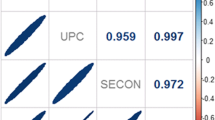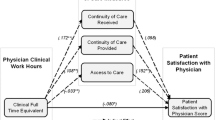Abstract
Background
Visit continuity is important to patients and valued by physicians. However, it is virtually impossible for primary care physicians (PCPs) to provide care during every paneled patient visit. It remains unclear whether PCP visit discontinuity can be planned in a way that is least disruptive to patients’ experiences with care.
Objective
This study aims to clarify whether visit continuity affects patients’ experiences with primary care equally for all patients.
Design
From January 2004 through March 2005, a large multispecialty practice in Massachusetts administered the Ambulatory Care Experience Survey (ACES) monthly to a random sample of patients visiting each of 145 PCPs. The analytic sample includes 14,835 patients with 2 or more primary care visits over the 6 months before being surveyed. Usual Provider Continuity (UPC), an administratively based measure of PCP visit continuity, was calculated for all respondents. Multilevel regression models that accounted for the clustering of patients within physicians modeled the relationship between UPC and each ACES measure. Interaction effects between UPC and gender, education, self-rated health, and PCP–patient relationship duration were tested.
Results
Physician–patient interaction quality, including physician communication, knowledge of the patient, health promotion support, and organizational access were more strongly influenced by visit continuity among respondents in early stages of a PCP–patient relationship (P < 0.01) and with worse self-rated health (P < 0.01).
Conclusions
Improvements in physician–patient relationship quality can be achieved by targeting visit continuity improvement efforts to patients who benefit most, particularly those in early stages of a PCP–patient relationship and/or perceive their health as poor.


Similar content being viewed by others
References
Mainous AG, III, Baker R, Love MM, Gray DP, Gill JM. Continuity of care and trust in one’s physician: evidence from primary care in the United States and the United Kingdom. Fam Med. 2001;33(1):22–7.
Schoen C, Osborn R, Huynh PT et al. Primary care and health system performance: adults’ experiences in five countries. Health Aff (Millwood). 2004;Suppl Web Exclusives:W4-503.
Saultz JW, Albedaiwi W. Interpersonal continuity of care and patient satisfaction: a critical review. Ann Fam Med. 2004;2(5):445–51.
Rodriguez HP, Rogers WH, Marshall RE, Safran DG. Multidisciplinary primary care teams: effects on the quality of clinician–patient interactions and organizational features of care. Med Care. 2007;45(1):19–27.
Ettner SL. The relationship between continuity of care and the health behaviors of patients: does having a usual physician make a difference? Med Care. 1999;37(6):547–55.
Lambrew JM, DeFriese GH, Carey TS, Ricketts TC, Biddle AK. The effects of having a regular doctor on access to primary care. Med Care. 1996;34(2):138–51.
O’Malley AS, Mandelblatt J, Gold K, Cagney KA, Kerner J. Continuity of care and the use of breast and cervical cancer screening services in a multiethnic community. Arch Intern Med. 1997;157(13):1462–70.
Doescher MP, Saver BG, Fiscella K, Franks P. Preventive care: does continuity count? J Gen Intern Med. 2004;19(6):632–7.
Flach SD, McCoy KD, Vaughn TE, Ward MM, Bootsmiller BJ, Doebbeling BN. Does patient-centered care improve provision of preventive services? J Gen Intern Med. 2004;19(10):1019–26.
Gill JM, Mainous AG, III. The role of provider continuity in preventing hospitalizations. Arch Fam Med. 1998;7(4):352–7.
Gill JM, Mainous AG, III, Nsereko M. The effect of continuity of care on emergency department use. Arch Fam Med. 2000;9(4):333–8.
Burge F, Lawson B, Johnston G. Family physician continuity of care and emergency department use in end-of-life cancer care. Med Care. 2003;41(8):992–1001.
Safran DG, Montgomery JE, Chang H, Murphy J, Rogers WH. Switching doctors: predictors of voluntary disenrollment from a primary physician’s practice. J Fam Pract. 2001;50(2):130–6.
Sorbero ME, Dick AW, Zwanziger J, Mukamel D, Weyl N. The effect of capitation on switching primary care physicians. Health Serv Res. 2003;38(1 Pt 1):191–209.
Stokes T, Tarrant C, Mainous AG, III, Schers H, Freeman G, Baker R. Continuity of care: is the personal doctor still important? A survey of general practitioners and family physicians in England and Wales, the United States, and The Netherlands. Ann Fam Med. 2005;3(4):353–9.
Blankfield RP, Kelly RB, Alemagno SA, King CM. Continuity of care in a family practice residency program. Impact on physician satisfaction. J Fam Pract 1990;31(1):69–73.
Weiss LJ, Blustein J. Faithful patients: the effect of long-term physician–patient relationships on the costs and use of health care by older Americans. Am J Public Health 1996;86(12):1742–7.
Saultz JW, Lochner J. Interpersonal continuity of care and care outcomes: a critical review. Ann Fam Med. 2005;3(2):159–66.
Cabana MD, Jee SH. Does continuity of care improve patient outcomes? J Fam Pract. 2004;53(12):974–80.
Schers H, Webster S, van den HH, Avery A, Grol R, van den BW. Continuity of care in general practice: a survey of patients’ views. Br J Gen Pract. 2002;52(479):459–62.
Nutting PA, Goodwin MA, Flocke SA, Zyzanski SJ, Stange KC. Continuity of primary care: to whom does it matter and when? Ann Fam Med. 2003;1(3):149–55.
Pereira AG, Pearson SD. Patient attitudes toward continuity of care. Arch Intern Med. 2003;163(8):909–12.
Mainous AG, III, Goodwin MA, Stange KC. Patient–physician shared experiences and value patients place on continuity of care. Ann Fam Med. 2004;2(5):452–4.
Christakis DA, Kazak AE, Wright JA, Zimmerman FJ, Bassett AL, Connell FA. What factors are associated with achieving high continuity of care? Fam Med. 2004;36(1):55–60.
Safran DG, Karp M, Coltin K et al. Measuring patients’ experiences with individual primary care physicians. Results of a statewide demonstration project. J Gen Intern Med. 2006;21(1):13–21.
Rodriguez HP, von Glahn T, Rogers WH, Chang H, Fanjiang G, Safran DG. Evaluating patients’ experiences with individual physicians: a randomized trial of mail, internet, and interactive voice response telephone administration of surveys. Med Care. 2006;44(2):167–74.
Breslau N, Reeb KG. Continuity of care in a university-based practice. J Med Educ. 1975;50(10):965–9.
Saultz JW. Defining and measuring interpersonal continuity of care. Ann Fam Med. 2003;1(3):134–43.
Jee SH, Cabana MD. Indices for continuity of care: a systematic review of the literature. Med Care Res Rev. 2006;63(2):158–88.
Rabe-Hesketh S, Pickles A, Skrondal A. GLLAMM Manual. Technical Report 2001/01, Department of Biostatistics and Computing, Institute of Psychiatry, King’s College, Unviersity of London. Available at http://www.gllamm.org. 2001. Ref Type: Report.
Skrondal A, Rabe-Hesketh S. Generalized Latent Variable Modeling: Multilevel, Longitudinal, and Structural Equation Models. London: Chapman and Hall/CRC Press; 2004.
Kao AC, Green DC, Davis NA, Koplan JP, Cleary PD. Patients’ trust in their physicians: effects of choice, continuity, and payment method. J Gen Intern Med. 1998;13(10):681–6.
O’Malley AS, Sheppard VB, Schwartz M, Mandelblatt J. The role of trust in use of preventive services among low-income African-American women. Prev Med. 2004;38(6):777–85.
Parchman ML, Burge SK. The patient–physician relationship, primary care attributes, and preventive services. Fam Med. 2004;36(1):22–7.
Mold JW, Fryer GE, Roberts AM. When do older patients change primary care physicians? J Am Board Fam Pract. 2004;17(6):453–60.
Donahue KE, Ashkin E, Pathman DE. Length of patient–physician relationship and patients’ satisfaction and preventive service use in the rural south: a cross-sectional telephone study. BMC Fam Pract. 2005;6:40.
Safran DG, Taira DA, Rogers WH, Kosinski M, Ware JE, Tarlov AR. Linking primary care performance to outcomes of care. J Fam Pract. 1998;47(3):213–20.
Parchman ML, Pugh JA, Noel PH, Larme AC. Continuity of care, self-management behaviors, and glucose control in patients with type 2 diabetes. Med Care. 2002;40(2):137–44.
Koopman RJ, Mainous AG, III, Baker R, Gill JM, Gilbert GE. Continuity of care and recognition of diabetes, hypertension, and hypercholesterolemia. Arch Intern Med. 2003;163(11):1357–61.
Mainous AG, III, Koopman RJ, Gill JM, Baker R, Pearson WS. Relationship between continuity of care and diabetes control: evidence from the Third National Health and Nutrition Examination Survey. Am J Public Health. 2004;94(1):66–70.
Wilson IB, Rogers WH, Chang H, Safran DG. Cost-related skipping of medications and other treatments among Medicare beneficiaries between 1998 and 2000. Results of a national study. J Gen Intern Med. 2005;20(8):715–20.
Jain S, Chou CL. Use of an orientation clinic to reduce failed new patient appointments in primary care. J Gen Intern Med. 2000;15(12):878–80.
Acknowledgements
We would like to thank Paul Cleary and Peter Marsden for their helpful suggestions on an early draft of the paper and the anonymous reviewers for their valuable insights that significantly strengthened the paper.
Conflict of Interest Statement
None disclosed.
Author information
Authors and Affiliations
Corresponding author
Appendix
Appendix
Rights and permissions
About this article
Cite this article
Rodriguez, H.P., Rogers, W.H., Marshall, R.E. et al. The Effects of Primary Care Physician Visit Continuity on Patients’ Experiences with Care. J GEN INTERN MED 22, 787–793 (2007). https://doi.org/10.1007/s11606-007-0182-8
Received:
Revised:
Accepted:
Published:
Issue Date:
DOI: https://doi.org/10.1007/s11606-007-0182-8




